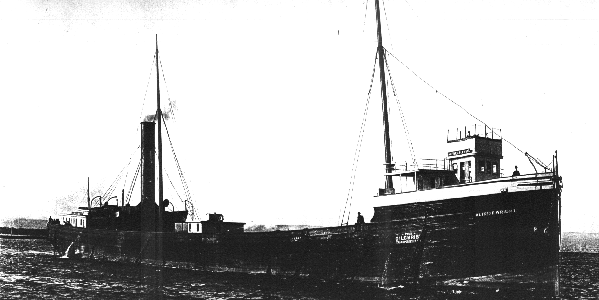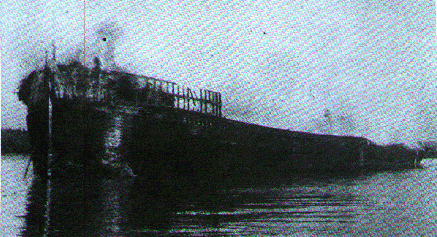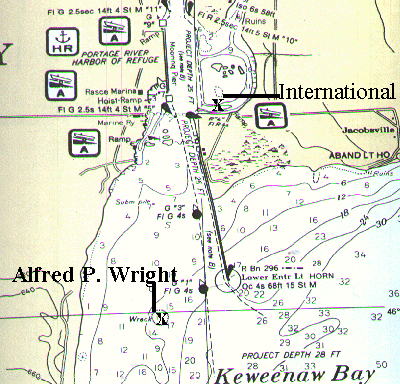

Type: Wooden Steamer Length: 286.0 x 41.5 x 22.3 ft., 2207 gt., 1899 nt. Depth: 10 - 15 ft. Location: South Entry LORAN: 31954.1 / 46749.5 LON/LAT: 46.57'95" / 88.26'40"

The Alfred P. Wright was downbound from Duluth with a cargo of 120,000 bu. of wheat when she docked at the White City amusement park on the eve of November 15, 1915 to shelter from a storm that was battering the area. Late that night, fire was discovered near her coal bunkers which quickly engulfed the old vessel. She burned to her hull, but remained afloat. Because she was an old vessel, plans were made to tow her to deep water and scuttle her, but she snagged the West edge of the canal while being towed. She was abandoned in place and dynamited after her engines and boilers were removed.
For years, her remains had been misidentified as belonging to the lumber hooker Charles H. Bradley. However, inconsistancies in the record led to further investigation of the wreck which was identified as the Alfred P. Wright by Marquette area diver Dan Fountain using hull measurements. The Wright was built in 1888 at Cleveland, Ohio by Thomas Quayle's Sons for Frank Perew of Buffalo, New York. She was originally rigged with 4 masts and topmasts and had 2 stacks with a red star on each, but subsequent rebuilds took two of her masts and one of her stacks. Her hull had one large compartment which could carry 3200 tons of coarse freight. Her double steeple compression engine was built in 1888 at Buffalo, New York by H.G. Grant and produced 400 hp at 70 revolutions. Her engine had 4 cylinders, 2 of 18x48" and 2 of 44x48". Her firebox boiler was 10.5 ft. deep x 17 ft. long and was built in 1888 by M. Riter at Buffalo, New York. She carried official number 106539.
Today the remains of the Wright can be found off the mouth of the Sturgeon River, just in from the West edge of the ship canal and WSW of the South Entry Light. She is still marked on NOAA charts as a hazard to navigation and can be easily located. Divers will find her hull and some machinery at the site, but sand periodically covers and uncovers parts of the wreck. The site can be easily reached from many boat launches in the area.

Other wrecks at the South Entry include the 80 ft. 130 gt. wooden excursion steamer International which burned at White City on November 2, 1913. Her remains lie on the bottom in a nearby slough on the North side of the canal. On October 23, 1876 the tug John Chassell burned at the South Entry. Her hull was towed out and sunk and has not been located. On August 28, 1882, the 422 ton wooden schooner Nellie McGilvray struck the pierhead at the South Entry and sank. After salvage attempts failed, the 12 year old vessel was dynamited as a hazard to navigation. Her remains were likely removed during subsequent canal dredging.
References: Keweenaw Shipwrecks by Fred Stonehouse, Julius F. Wolff Jr.'s Lake Superior Shipwrecks, White City by Clarence Monette, the Dave Swayze Wrecklist, Michigan Technological University Archives, Dan Fountain, Milwaukee Public Library - Herman Runge Collection, Jim Jackman